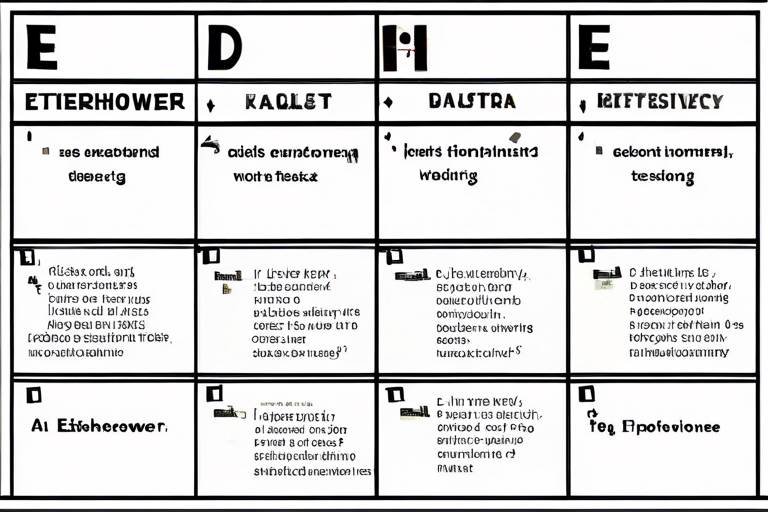How to Create a System for Efficient Project Tracking
Effective project tracking is essential for successful project management. By establishing a systematic approach to tracking progress, teams can stay organized, meet deadlines, and achieve project goals efficiently. Let's delve into the key strategies for creating a robust project tracking system.
Setting clear and measurable objectives is the cornerstone of efficient project tracking. When objectives are well-defined, it becomes easier to break down the project into manageable tasks, track progress, and measure success. Think of objectives as the guiding stars that keep the project on course.
Project management tools such as Trello, Asana, or Jira can be invaluable in simplifying project tracking. These tools offer features like task assignment, progress visualization, and team collaboration, making it easier to monitor project status and ensure everyone is on the same page.
Breaking the project into milestones with clear deadlines provides checkpoints for tracking progress effectively. Milestones serve as markers of achievement and help in evaluating whether the project is moving forward as planned. Deadlines create a sense of urgency and drive team members towards timely completion.
Clarity in assigning roles and responsibilities is crucial for efficient project tracking. When team members know what is expected of them and who is accountable for each task, workflow becomes smoother, and progress can be monitored more effectively. It's like having a well-oiled machine where every part knows its function.
Scheduling regular progress updates and team meetings fosters communication and transparency. By sharing achievements, discussing challenges, and making necessary adjustments in real-time, the project can adapt to evolving circumstances and stay on track towards completion.
Integrating feedback mechanisms into the project tracking system allows for continuous improvement. Feedback from team members and stakeholders provides valuable insights, identifies potential issues, and enables adjustments to enhance overall project efficiency. It's like having a compass that guides you in the right direction.
Tracking relevant KPIs offers a quantitative view of project performance. Metrics such as budget utilization, timeline adherence, and quality standards serve as indicators of progress and help in making data-driven decisions to ensure project success. Monitoring KPIs is akin to having a dashboard that displays the vital signs of the project.
Flexibility is key in project tracking. Projects are dynamic, and unforeseen challenges may arise. By staying open to adjustments, embracing change, and pivoting strategies when necessary, teams can navigate obstacles and steer the project towards successful completion. It's like sailing a ship, adjusting the sails to reach the desired destination.
Below are some common questions about creating an efficient project tracking system:
- How do project objectives impact tracking? - Clear objectives provide a roadmap for tracking progress and measuring success.
- Why is regular communication important in project tracking? - Communication ensures that team members are aligned, informed, and can address challenges promptly.
- What role does feedback play in improving project efficiency? - Feedback helps in identifying areas for improvement, making necessary adjustments, and enhancing overall project performance.
- Why is it essential to monitor KPIs during a project? - KPIs offer insights into project performance, enabling informed decision-making and ensuring project success.
- How can flexibility contribute to effective project tracking? - Being flexible allows teams to adapt to changes, pivot strategies, and overcome obstacles to keep the project on track.
Define Clear Objectives
When embarking on a new project, one of the fundamental steps to ensure efficient project tracking is to . These objectives serve as the roadmap guiding the project towards successful completion. By setting specific and measurable goals, project managers can effectively communicate the project's purpose and expected outcomes to the team.
Clear objectives act as a guiding light, illuminating the path for all project stakeholders. They provide a clear direction, helping team members understand their roles and responsibilities within the project framework. Without well-defined objectives, projects can easily veer off course, leading to confusion, delays, and inefficiencies.
Imagine setting off on a journey without a destination in mind. How would you know which way to go or when you've reached your destination? Similarly, in project management, clear objectives serve as the destination point, guiding every decision, action, and milestone along the way.
Moreover, defined objectives enable project managers to break down the project into smaller, manageable tasks. This segmentation facilitates better tracking of progress, as each task contributes to the overall objective. It also allows for a more accurate assessment of project advancement and helps in identifying potential bottlenecks or areas needing attention.
By establishing clear objectives at the outset of a project, teams can align their efforts towards a common goal. This alignment fosters collaboration, boosts motivation, and enhances overall productivity. It provides a sense of purpose and direction, instilling a shared vision that propels the project forward.
Utilize Project Management Tools
When it comes to efficient project tracking, one of the key strategies is to . These tools are designed to streamline project workflows, enhance collaboration, and improve overall productivity. By incorporating tools such as Trello, Asana, or Jira into your project tracking system, you can effectively manage tasks, monitor progress, and ensure that deadlines are met.
Project management tools offer a range of features that can benefit project teams. From task assignment and progress tracking to file sharing and communication, these tools provide a centralized platform for team members to collaborate and stay organized. By leveraging the capabilities of these tools, project managers can optimize project tracking processes and facilitate seamless coordination among team members.
Furthermore, project management tools enable real-time visibility into project status and performance. Team members can easily access project timelines, task lists, and updates, allowing for transparency and accountability throughout the project lifecycle. This transparency not only fosters better communication but also enhances decision-making and problem-solving within the team.
By utilizing project management tools effectively, project teams can streamline their workflows, improve efficiency, and ultimately achieve greater project success. These tools serve as a digital hub for project tracking, offering a comprehensive solution for managing tasks, timelines, and team collaboration. With the right tools in place, project tracking becomes more organized, productive, and ultimately more successful.
Establish Milestones and Deadlines
Establishing milestones and deadlines is like setting signposts along a winding road; they guide the project team towards the ultimate destination of successful completion. Imagine embarking on a journey without any markers or time constraints – chaos would reign, and progress would be uncertain. Similarly, in project management, milestones serve as crucial checkpoints that signify progress and achievement, while deadlines create a sense of urgency and accountability.
When setting milestones, it's essential to break down the project into manageable chunks, akin to dividing a large puzzle into smaller, more digestible pieces. Each milestone represents a significant step towards the project's completion, allowing the team to track progress incrementally. By establishing clear deadlines for each milestone, project managers create a sense of rhythm and momentum, ensuring that tasks are completed in a timely manner.
Furthermore, milestones and deadlines provide a framework for measuring progress and identifying potential bottlenecks. Just as a marathon runner relies on mile markers to pace themselves and adjust their strategy, project teams can use milestones to assess their performance, make necessary adjustments, and stay on course towards the project's goals.
Incorporating milestones and deadlines into project tracking not only fosters a sense of achievement but also instills a sense of accountability among team members. Each milestone reached and deadline met symbolizes progress and dedication, motivating team members to stay focused and committed to the project's success.
Assign Responsibilities Clearly
Assigning responsibilities clearly is a fundamental aspect of efficient project tracking. When team members have well-defined roles and tasks, it minimizes confusion and ensures that everyone knows what is expected of them. Think of it as a relay race where each runner knows exactly when to pass the baton to the next, ensuring a smooth transition and progress towards the finish line.
One way to establish clear responsibilities is by creating a responsibility matrix that outlines who is accountable for each task and decision within the project. This matrix can be a simple table that clearly defines roles, responsibilities, and levels of authority. By having this visual representation, team members can easily refer back to it when in doubt, promoting clarity and accountability.
Moreover, setting SMART goals (Specific, Measurable, Achievable, Relevant, Time-bound) for each team member helps in clearly defining what needs to be accomplished. When goals are specific and measurable, it becomes easier to track progress and evaluate performance. This approach not only clarifies responsibilities but also motivates team members to achieve their objectives within the set timeframe.
Another effective way to assign responsibilities clearly is by fostering a culture of open communication within the team. Encouraging team members to ask questions, seek clarification, and provide updates on their tasks promotes transparency and ensures that everyone is on the same page. Regular check-ins and feedback sessions can also help in addressing any ambiguity or overlapping responsibilities, fostering a collaborative and efficient work environment.
In addition to individual responsibilities, it is essential to define team goals and ensure that each member understands how their contribution fits into the bigger picture. When team members have a clear understanding of the project's overall objectives and their role in achieving them, it fosters a sense of ownership and commitment towards successful project completion.
Ultimately, assigning responsibilities clearly is not just about delegating tasks; it is about empowering team members to take ownership of their work, collaborate effectively, and contribute towards the collective success of the project. By establishing clear roles, setting expectations, and promoting open communication, project tracking becomes more streamlined and efficient, leading to successful project outcomes.
Regular Progress Updates
Regular progress updates are like checkpoints on a long journey, ensuring that you are on the right path and moving forward towards your destination. These updates serve as a compass, guiding the team through the project's twists and turns, keeping everyone informed and engaged.
Imagine a ship sailing through rough seas; without regular updates on the weather conditions and course adjustments, the ship risks getting lost or encountering unexpected obstacles. Similarly, in a project, without consistent progress updates, the team may lose sight of the project's objectives, leading to delays or inefficiencies.
One effective way to ensure regular progress updates is to schedule weekly or bi-weekly meetings where team members share their accomplishments, challenges, and upcoming tasks. These meetings foster transparency, collaboration, and accountability among team members, creating a sense of unity and shared responsibility.
Moreover, utilizing project management tools that offer real-time updates and notifications can streamline the progress tracking process. Tools like Gantt charts or Kanban boards provide visual representations of tasks and deadlines, making it easier to identify bottlenecks and adjust priorities accordingly.
During progress updates, it is crucial to celebrate achievements, no matter how small, and address obstacles promptly. Recognizing team members' efforts boosts morale and motivation, while addressing challenges proactively prevents them from escalating and derailing the project's progress.
Remember, regular progress updates are not just about reporting numbers and percentages; they are about fostering a culture of communication, collaboration, and continuous improvement. By staying updated on the project's status and addressing issues promptly, the team can navigate through uncertainties and challenges with confidence, ensuring successful project completion.
Implement Feedback Mechanisms
Implementing feedback mechanisms is a critical aspect of efficient project tracking. By integrating feedback loops within the project management process, teams can gather valuable insights that contribute to continuous improvement and enhanced performance. Feedback mechanisms serve as a channel for team members and stakeholders to share their perspectives, raise concerns, and suggest improvements, fostering a culture of open communication and collaboration.
One effective way to implement feedback mechanisms is to establish regular feedback sessions or surveys where team members can provide input on various aspects of the project. These sessions can focus on gathering feedback on processes, communication effectiveness, team dynamics, and overall project progress. By actively seeking and valuing feedback, project managers can identify potential issues early on, address concerns promptly, and make informed decisions to optimize project outcomes.
Furthermore, creating a structured feedback mechanism, such as a feedback form or online platform, can streamline the collection and analysis of feedback. This approach not only ensures that feedback is systematically documented but also allows for tracking trends, identifying recurring issues, and implementing targeted solutions to enhance project performance.
Feedback mechanisms also play a crucial role in fostering a culture of continuous learning and development within the project team. By encouraging constructive feedback and recognizing the value of diverse perspectives, teams can leverage feedback as a catalyst for innovation, problem-solving, and growth. Embracing feedback as a tool for improvement empowers team members to contribute meaningfully to the project's success and cultivates a sense of shared ownership and accountability.
Monitor Key Performance Indicators (KPIs)
When it comes to effective project tracking, monitoring Key Performance Indicators (KPIs) plays a vital role in assessing the project's performance and ensuring alignment with the set objectives. KPIs are quantifiable metrics that reflect the critical success factors of a project, providing valuable insights into various aspects of project management.
By monitoring KPIs, project managers can track the progress of the project in real-time and identify any deviations from the planned course. Key metrics such as budget utilization, timeline adherence, resource allocation, and quality standards serve as indicators of the project's health and performance.
Setting up a dashboard that displays these KPIs in a clear and visual manner can help team members and stakeholders easily grasp the project's status and performance. This transparency fosters accountability, drives motivation, and enables informed decision-making to address any issues or bottlenecks promptly.
Moreover, regular monitoring of KPIs allows project managers to proactively manage risks, make data-driven decisions, and optimize resources for better project outcomes. It facilitates a proactive approach to project tracking, enabling timely interventions and adjustments to ensure project success.
Adapt and Pivot as Needed
Adaptability and flexibility are crucial aspects of successful project tracking. In the dynamic environment of project management, being able to adapt and pivot as needed ensures that the project stays on course towards its objectives. Just like a skilled pilot adjusts the flight path to navigate through changing weather conditions, project managers must be ready to make course corrections to avoid obstacles and reach their destination successfully.
When unforeseen challenges arise or market conditions shift, the ability to pivot allows project teams to respond effectively. It's like a skilled chess player who adjusts their strategy based on their opponent's moves, staying focused on the end goal while being flexible in their approach. By embracing change and proactively making necessary adjustments, project tracking becomes more resilient and capable of overcoming unexpected hurdles.
By fostering a culture of adaptability within the team, project managers empower their members to think creatively and problem-solve in real-time. It's akin to a well-rehearsed orchestra that can seamlessly adjust the tempo or dynamics during a performance to deliver a flawless musical piece. Embracing adaptability not only improves project tracking but also enhances team collaboration and morale, leading to greater overall success.
Furthermore, pivoting when needed allows project managers to capitalize on emerging opportunities and optimize resources effectively. Just as a skilled surfer adjusts their position on the board to catch the perfect wave, project teams can pivot their strategies to ride the wave of success. By staying agile and responsive to changing circumstances, projects can stay competitive, innovative, and ahead of the curve in a fast-paced business landscape.
Frequently Asked Questions
- What are the benefits of efficient project tracking?
Efficient project tracking offers several benefits, including improved productivity, timely completion of tasks, better decision-making, and enhanced collaboration among team members. It helps in identifying bottlenecks early, ensuring project alignment with objectives, and ultimately leading to successful project outcomes.
- How can project management tools aid in project tracking?
Project management tools like Trello, Asana, or Jira provide features for task assignment, progress monitoring, and team collaboration. These tools centralize project information, streamline communication, and offer visibility into project status, making tracking more efficient and effective.
- Why is it important to establish milestones and deadlines in project tracking?
Setting milestones with deadlines helps in breaking down the project into manageable parts, tracking progress, and ensuring timely completion. Milestones serve as checkpoints for evaluating project advancement, maintaining focus, and proactively addressing any deviations from the project plan.
- How does regular progress updates contribute to efficient project tracking?
Regular progress updates keep team members informed, aligned, and accountable for their tasks. These updates facilitate real-time communication, problem-solving, and decision-making, fostering a transparent work environment and enabling timely adjustments to ensure project success.
- What role do feedback mechanisms play in enhancing project tracking?
Feedback mechanisms enable continuous improvement by gathering insights, identifying issues, and implementing necessary adjustments. Feedback from stakeholders and team members helps in addressing challenges, refining processes, and enhancing overall project efficiency and effectiveness.



















